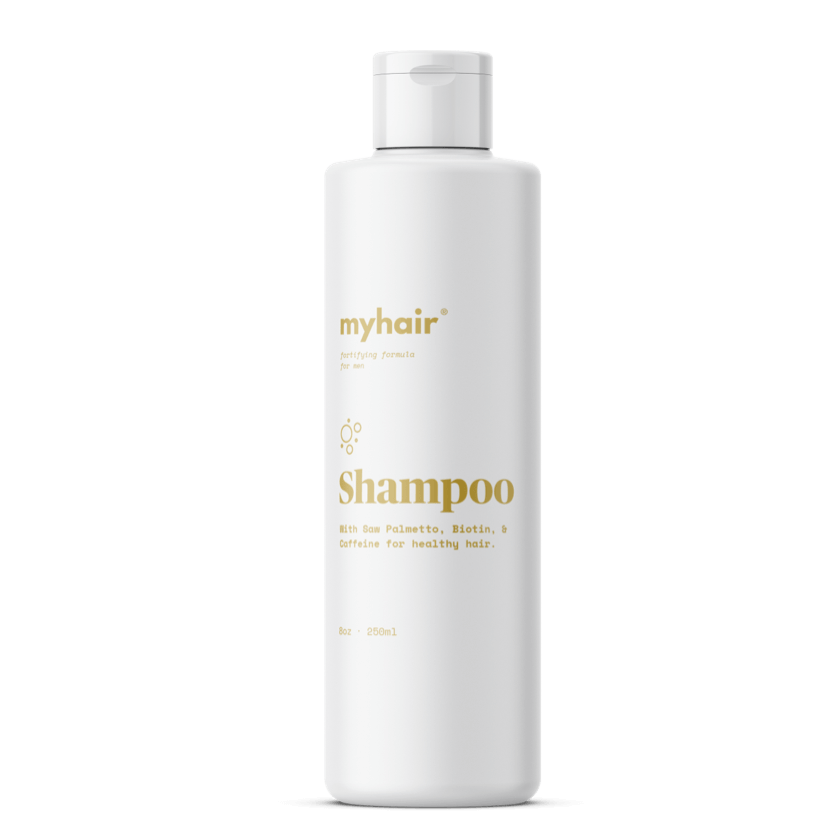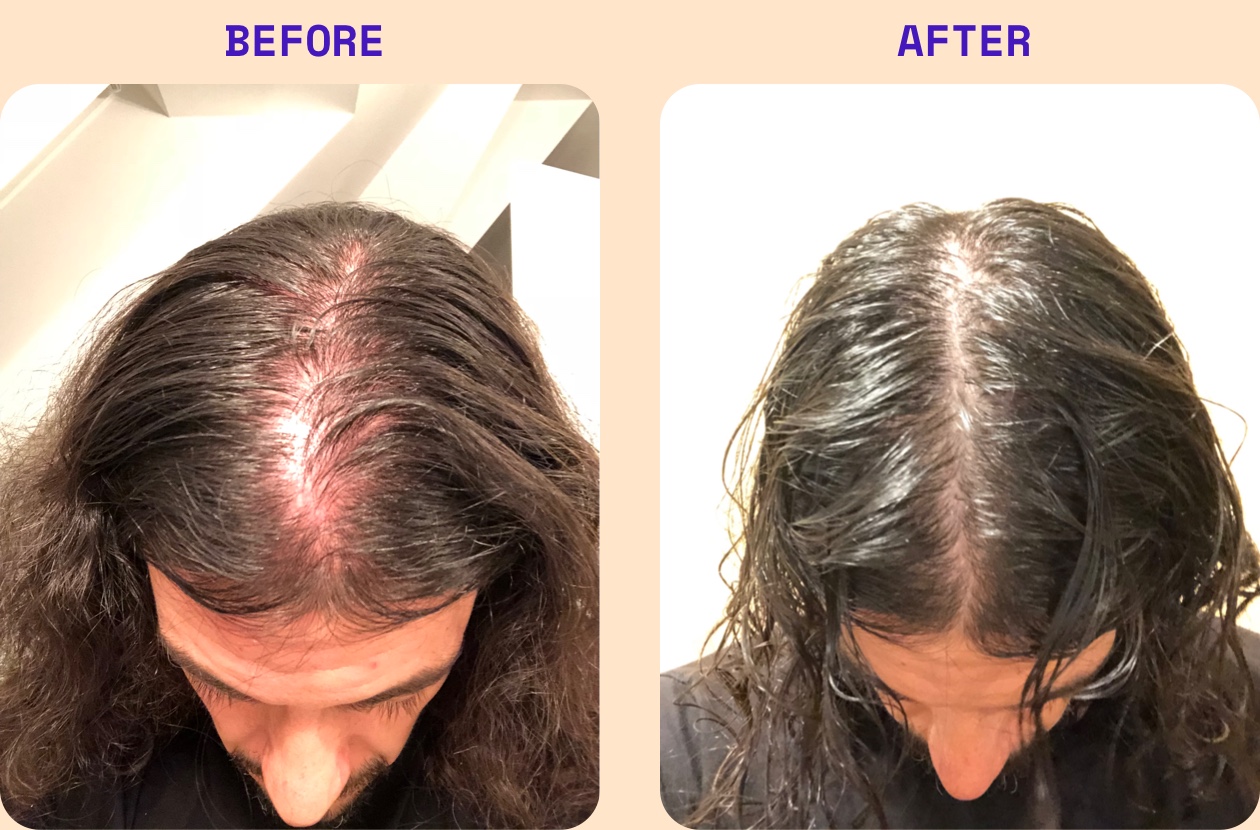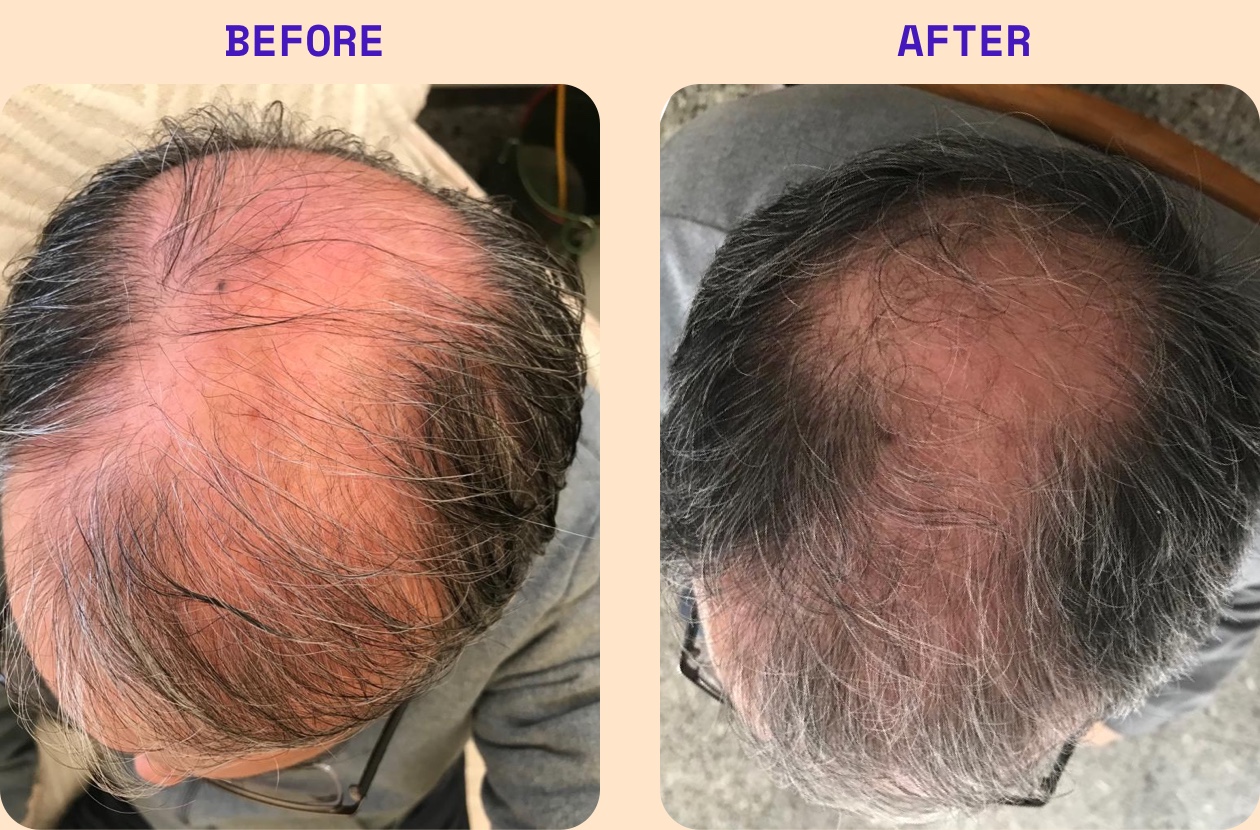Shampoo
Enriched with natural DHT blockers and antioxidants
from $26.70/month
Included in The Kit
Everything you need for the healthiest hair

MINOXIDIL
Increasing blood flow to stimulate your hair follicles

NUTRIENTS
The building blocks your body needs to produce healthy hair

SHAMPOO
Cleansing and nourishing your hair and scalp
Included in The Kit
Gentle on the scalp microbiome
If you want healthy hair, you need to start at the root. Our shampoo thoroughly cleanses hair but is still kind to your scalp, where your hair follicles reside.
READ MORE


Powerful natural ingredients
Sometimes natural ingredients are all you need. We’ve designed a custom blend of antioxidants, DHT blockers, and natural oils to cleanse and condition your hair.
READ MORE
Refreshingly effective
From tingly peppermint oil to caffeine extract, our Shampoo is infused with a variety of ingredients that turn it into an all-natural pick me up.


Our shampoo has been clinically tested and proven to be safe to your scalp
For the healthiest hair, start at the scalp
Specially designed for weak or thinning hair








Argan oil
Many shampoos are focused on getting dirt, pollutants, and oily build-up out of your hair. While this may sound good, those shampoos strip your hair, leaving it dry and brittle. They can also damage your scalp’s microbiome.
We infused antioxidant-rich argan oil into our Shampoo because it can penetrate damaged hairs and hair follicles, repairing them. With argan oil, you’ll get rid of free radicals and end up with silky, shiny hair. 1
Saw palmetto
Many people with androgenic alopecia have high levels of an androgen called DHT (dihydrotestosterone). Saw palmetto is a natural DHT blocker that can help lower levels of this hormone.
This plant extract works by reducing the amount of testosterone that your body turns into DHT. Once the excess DHT around your hair follicles is gone, natural DHT blockers like saw palmetto can also encourage your hair follicles to start producing hair again. 1, 5
Epigallocatechin gallate (EGCG)
Whether or not you’re a tea drinker, you’ve probably heard of green tea and how good it is for your health. You don’t need to drink tea to reap these benefits, though. You can get most of green tea’s advantages through epigallocatechin gallate (EGCG).
This antioxidant compound is known for having a variety of beneficial properties, including antimicrobial and anti-inflammatory effects. EGCG also works as a natural DHT blocker and has been shown to be good for skin. 2
Caffeine
If you’re not a fan of coffee or tea in the mornings, there’s another way to get your morning pick me up. Caffeine is a natural DHT (dihydrotestosterone) blocker that can be absorbed into your skin and hair follicles.
Many people with androgenic alopecia have high levels of DHT, particularly around their hair follicles. Once absorbed into the scalp, natural DHT blockers like caffeine can help regulate hair growth factors, elongate hair shafts, and boost hair growth. 3
Horsetail extract
Despite its misleading name, horsetail extract doesn’t come from a horse’s tail. It’s actually made from an evergreen plant.
Horsetail extract is rich in three nutrients: silica, selenium, and cysteine. These are three important building blocks that are essential for your hair.
The silica in horsetail extract is particularly important. It helps your body make keratin, one of the main components used to create hair strands. 4
Rosemary extract
You’ve probably eaten rosemary at some point in your life. But this herb isn’t just for cooking — it also has many health benefits.
Rosemary extract is best known for its powerful antioxidant properties, which can remove harmful free radicals from your hair. It’s also antimicrobial and can help improve your scalp microbiome.
Rosemary is an excellent cleansing and conditioning agent. It removes oily build-up while adding volume and shine to hair. 5
Sage extract
Sage is an aromatic herb with well-known antioxidant and antimicrobial properties. This plant extract also contains a variety of anti-inflammatory compounds.
Herbs like sage are often low in nutrients. But sage extract contains minerals like calcium and potassium, as well as A, B-complex, and C vitamins — which are all important for your hair. 5
Peppermint oil
Like other essential oils and extracts, peppermint oil has antioxidant and antimicrobial properties. However, peppermint has unique benefits for your hair and scalp due to one specific compound: menthol. 6
The menthol in peppermint oil acts as a vasodilator, increasing blood flow to your scalp and hair follicles. Another benefit? Each time you wash your hair, you’ll get to enjoy the refreshing smell and tingly feeling that menthol gives, too.
For the healthiest hair, start at the scalp
Specially designed for weak or thinning hair
GET IT BACK
Get to the root of it.
Everything you need & nothing you don’t.
FAQs
Got questions? We have answers.
What’s so special about Shampoo?
Did we mention it’s fully vegan (which also means never tested on animals) and parabens free? Not to brag, but we think this is the best cleansing and conditioning shampoo for weak or thinning hair.
What is a DHT blocker? Do DHT blockers really work?
Which ingredients in Shampoo act as DHT blockers?
What are the natural antioxidants in Shampoo and why are they important?
How does Shampoo also condition hair?

DHT Blocking Shampoos, Supplements, and Medications
Many people with androgenic alopecia (also commonly known as male pattern hair loss) think that their hair problems are hereditary. And in part, this is true. But patterned hair loss is also caused by other factors, like the levels of hormones circulating in your body. Some treatments for androgenic alopecia work by reducing the levels of these hormones.
Androgenic alopecia and androgens
When you were young, you probably looked at bald or balding people with a sense of dread. Growing up, most of us were told that if we had bald family members, there was a good sense we’d eventually become bald, too.
While genetics play a role in hair loss, they aren’t the only factor causing this problem. Hormones also play an important role in androgenic alopecia.7 Also, this condition isn’t a problem that just affects seniors. People can start showing the first signs of pattern hair loss when they’re still teenagers.
The major hormones that play a role in androgenic alopecia are known as androgens. While you might not be familiar with these types of hormones, you’ve almost certainly heard of one androgen in particular: testosterone. Testosterone is the primary sex hormone that men express and plays a huge role in their development during puberty.
Now, it isn’t exactly testosterone itself that causes balding. This hormone is converted into a different androgen, DHT (dihydrotestosterone), by an enzyme family called 5-alpha reductase (5-αR). It’s both the 5-αR enzyme family and dihydrotestosterone that have been associated with androgenic alopecia.8
Blocking DHT
Testosterone, DHT, and 5-alpha reductase enzymes are all important for healthy development.9, 10 However, when too much DHT is produced, hair loss becomes much more likely.
In fact, scientists have discovered that both 5-αR enzyme activity and DHT levels increase in people with androgenic alopecia. The easiest way to prevent these increases from happening is to block DHT’s production. This means stopping 5-αR enzymes from converting testosterone to DHT.
These days, both oral and topical DHT blockers exist. Some target just one type of 5-αR enzyme, while others target multiple types.
Oral DHT blockers for hair regrowth
DHT blockers are more common than you think. From shampoos to prescription medications to some of the foods you eat, DHT blockers are all around you.
Prescription oral DHT blockers
One of the most well-known DHT blockers is a prescription medication called finasteride. This drug, which is sometimes prescribed for prostate problems, targets Type 2 5-αR enzymes. It’s also the only FDA-approved oral medication for androgenic alopecia.
You may have also heard of a newer, similar medication called dutasteride. This prescription medication is a lot like finasteride, but targets multiple 5-αR enzymes. However, dutasteride is currently only available in Asia; the FDA hasn’t yet approved it in the USA.
These medications are very effective, but they tend to come with side effects. Sexual side effects, like loss of sex drive or impotence, are particularly challenging for men who choose to take these medications. While many men see these side effects go away over time, a large amount end up switching to an alternative hair loss treatment, like minoxidil.
To try and reduce these side effects, and also direct the drug’s action to just the skin and hair follicles at the scalp, topical versions of these medications are being developed. While they do seem promising, they’re still at the research stage and aren’t yet available to purchase.
Natural oral DHT blockers
Several foods and spices are also technically oral DHT blockers. If you enjoy nettle, jasmine, or green tea, Thai curries, gooseberry jam, or fresh black pepper, you might already be consuming natural DHT blockers.
Herbs and spices like nettle, snake jasmine, green tea, lemongrass, ginger, galangal, and black pepper are all plants with DHT-blocking properties. Other DHT blockers you might eat regularly include plants like Indian gooseberries, oyster and shiitake mushrooms, kaffir limes, starfruit, and winter melon (also called wax gourd).9, 11
Of course, you can’t really compare taking a prescription medication to eating a diet rich in these foods. But that isn’t to say that these natural DHT blockers are ineffective. Some people even take supplements containing natural DHT blockers like saw palmetto, a potent 5-αR enzyme blocker that is considered to have fewer side effects than finasteride.12, 13
Topical DHT blockers and hair
It might not surprise you to learn that a lot of the spices, herbs, and other natural DHT blocking plants are used as topical, naturopathic hair loss treatments. In traditional Asian medicine, many of these plants are turned into juices or extracts and applied topically to the scalp. One research paper even reported that a mixture of coconut oil, lime juice, and boiled gooseberries is used as a homemade shampoo that promotes growth and prevents hair loss.14
DHT Blocking Shampoos and Conditioners
Applying extracts, oils, and homemade mixtures to your head isn’t so common in Western countries. Instead, more convenient solutions tend to include DHT-blocking shampoos, conditioners, and lotions.
Hair products may be infused with a range of different natural DHT blockers, including saw palmetto, caffeine, and nettle, though the more aromatic ingredients, like lemongrass and ginger, are just as popular. You’re unlikely to see DHT blockers like mushrooms on the ingredients list of your hair products, and you certainly won’t see any prescription DHT blockers, despite finasteride lotions being developed.
Choosing the right DHT blocking shampoo
There currently isn’t any ranking available of the potency of natural DHT blockers. Even if there was, you probably wouldn’t be able to compare products accurately since few state the exact amounts of DHT blocking plant extracts that they include in their formulas.
That being said, one of the most potent natural DHT blockers is saw palmetto. Recent reports on the effectiveness of saw palmetto-infused products on the hair and scalp have shown great promise. People who used a DHT-blocking shampoo and lotion with saw palmetto saw increased hair growth and reduction in the oiliness of their scalps. Similarly, when saw palmetto was added to an anti-fungal shampoo, it actually improved its overall effects.15
Another DHT-blocking shampoo is actually caffeinated shampoo, a product that’s commonly available at most pharmacies and supermarkets. Caffeine is also a DHT-blocker. It’s thought to help hair growth by regulating hair growth factors and lengthening hair shafts.3 Our Shampoo includes both caffeine and saw palmetto DHT blockers.
Using a DHT blocking shampoo
Whether you’re using caffeinated shampoo, saw palmetto-infused shampoo, or another shampoo entirely, there’s a trick to using DHT blocking shampoo. Unlike most other shampoos you’ve used in your life, which get lathered on and washed off straight away, you want to let your DHT blocking shampoo sit on your head for a few minutes. In fact, if you can leave it on for the full duration of your shower (applying it at the start and only washing it off at the very end), that’s even better. This allows the DHT blocking ingredients in your shampoo to absorb into your scalp and hair follicles.
Which DHT blockers should I use?
If you’re looking for a DHT blocker that will treat androgenic alopecia, the only FDA-recommended option in the USA is finasteride. But if, like many, you’re wary of sexual dysfunction and other negative side effects, you might want to consider a more natural option.
Minoxidil, a topical, FDA-approved treatment for androgenic alopecia, has far fewer side effects than finasteride. It acts as a vasodilator, rather than a DHT blocker, which means that it can be combined with alternative treatments to maximize its effects. And since the FDA recommends using it with a mild cleansing agent, a gentle DHT blocking shampoo with natural ingredients is perfectly safe to use alongside it.16
With your doctor’s approval, minoxidil can also be combined with finasteride. However, another option would be to pair a DHT-blocking supplement with minoxidil, since these have also had positive preliminary results for people with androgenic alopecia.15
In addition to using a DHT blocking shampoo and supplements, you can try making some culinary changes that increase the amount of natural DHT-blockers you’re consuming on a daily basis. From Thai green curry to a simple mushroom stir fry, there are tons of ways to increase the amount of natural DHT blockers in your life.
References
- Guillaume, D., & Charrouf, Z. (2013). Argan oil for nutritional and skin care applications. H&PC Today, 8, 28-30.
- Frasheri, L., Schielein, M. C., Tizek, L., Mikschl, P., Biedermann, T., & Zink, A. (2020). Great green tea ingredient? A narrative literature review on epigallocatechin gallate and its biophysical properties for topical use in dermatology. Phytotherapy Research.
- Völker, J. M., Koch, N., Becker, M., & Klenk, A. (2020). Caffeine and Its Pharmacological Benefits in the Management of Androgenetic Alopecia: A Review. Skin Pharmacology and Physiology, 33(3), 93-109.
- Janowiak, J. J., & Ham, C. (2004). A Practitioner’s Guide to Hair Loss Part 1—History, Biology, Genetics, Prevention, Conventional Treatments, and Herbals. Alternative and Complementary Therapies, 10(3), 135–143.doi:10.1089/1076280041138207
- Bergfeld, W. F., & Andersen, F. A. (2008). Natural products for hair care and treatment. In Hair Growth and Disorders (pp. 515-524). Springer, Berlin, Heidelberg.
- Craighead, D. H., & Alexander, L. M. (2016). Topical menthol increases cutaneous blood flow. Microvascular research, 107, 39-45.
- Gupta, M., & Mysore, V. (2016). Classifications of patterned hair loss: a review. Journal of cutaneous and aesthetic surgery, 9(1), 3.
- Ustuner, E. T. (2013). Cause of androgenic alopecia: crux of the matter. Plastic and reconstructive surgery Global open, 1(7).
- Kumar, N., Rungseevijitprapa, W., Narkkhong, N. A., Suttajit, M., & Chaiyasut, C. (2012). 5α-reductase inhibition and hair growth promotion of some Thai plants traditionally used for hair treatment. Journal of ethnopharmacology, 139(3), 765-771.
- Dhurat, R., Sharma, A., Rudnicka, L., Kroumpouzos, G., Kassir, M., Galadari, H., … & Goldust, M. (2020). 5‐Alpha reductase inhibitors in androgenetic alopecia: Shifting paradigms, current concepts, comparative efficacy, and safety. Dermatologic Therapy, e13379.
- Nahata, A., & Dixit, V. K. (2014). Evaluation of 5α‐reductase inhibitory activity of certain herbs useful as antiandrogens. Andrologia, 46(6), 592-601.
- Chatterjee, S., & Agrawala, S. K. (2003). Saw palmetto (Serenoa repens) in androgenic alopecia An effective phytotherapy.
- Patel, B., Velasco, M. A. M., Gutierrez, F. T., & Khesin, D. (2017). Addressing androgenetic Alopecia-A complex disorder-with a multilateral treatment strategy. MOJ Bioequiv Availab, 3(1), 00025.
- Pundkar, A. S., Murkute, P. M., Wani, S., & Tathe, M. A REVIEW: HERBAL THERAPY USED IN HAIR LOSS.
- Murugusundram, S. (2009). Serenoa repens: does it have any role in the management of androgenetic alopecia?. Journal of cutaneous and aesthetic surgery, 2(1), 31.
- HEB Minoxidil Topical Solution USP, 5% Drug Facts. (2017). Retrieved January 13, 2021, from Nih.gov website: https://dailymed.nlm.nih.gov/dailymed/fda/fdaDrugXsl.cfm?setid=81489e33-92be-45a5-9fa1-b352b640340b&type=display#:~:text=Use%20a%20mild%20shampoo%20if,applying%20minoxidil%20topical%20solution%205%25.&text=Squeeze%20the%20rubber%20bulb%20and,amount%20back%20into%20the%20bottle.
Included in The Kit

MINOXIDIL

NUTRIENTS

SHAMPOO
Included in The Kit
Stopping Hair Loss
Guides & Articles
Can you experience hair loss from not showering?
It isn’t possible to directly experience hair loss from not showering. However, not showering does allow for an increase in the number and type of harmful bacteria and fungi living on your scalp. This, in turn, can increase your risk of dandruff, scalp infections, and hair loss.
Can you use green tea for hair growth?
Green tea is made from leaves of the plant Camellia sinensis. This plant, which is rich in powerful antioxidants, beneficial bioactive compounds, and nutrients, also has DHT-blocking properties. DHT is the main hormone involved in pattern hair loss.
Using caffeine for hair growth
Caffeine is a chemical with a ton of health benefits. It’s also a DHT blocker, like finasteride. When applied directly to your scalp, caffeine enters your hair follicles in at little as 2 minutes. This makes it the ideal ingredient to incorporate into shampoos, conditioners, and other hair products.
















